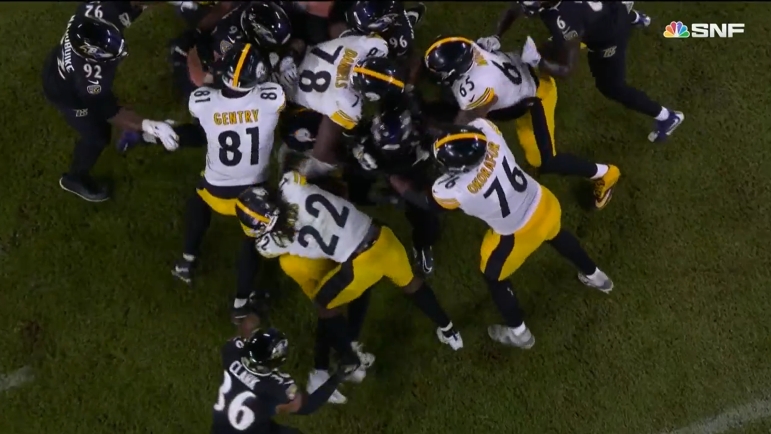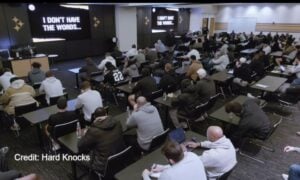The 2022 season was surely just as dramatic as any season the NFL has ever produced. However, much to the groaning of many fans, few of which were Philadelphia Eagles supporters, one scenario was often void of much drama at all: 3rd or 4th and a yard to go. This is thanks in large part to a loophole in the rulebook exploited by many teams across the league allowing multiple other players to push its quarterback across the line to gain for a much easier first down or touchdown.
According to Sports Info Solutions via the New York Times, the NFL saw just 73 total quarterback sneaks in 2016. That number has since spiked to 291 attempts in 2022, which was up from 243 in 2021 and 170 in 2020. The success rate has as much a reason to utilize the push as any. The Philadelphia Eagles, en route to a Super Bowl appearance, alone attempted 32 of those 291 QB sneaks in the 2022 season, converting a whopping 29 of them for a 90.6% conversion rate. The rest of the league converted 82% of its QB sneak attempts.
Despite the perceived lack of drama or appearance of a situation wholly unfair to defenses, the NFL’s competition committee won’t be entertaining the idea of removing the ability to push the quarterback with any assortment of players in 2023 during next week’s owners meetings. Pittsburgh Steelers head coach Mike Tomlin, of course, sits on the NFL’s competition committee, giving his thoughts on the matter significant weight.
“I think whether or not you can stop someone from getting a yard, there’s a lot of variables in that discussion,” Tomlin said on former Steelers quarterback Ben Roethlisberger’s Footbahlin podcast in early March. “But I think we’re going to see the defensive coaches’ collective response to it in 2023. And I think, probably, that’s what’s going to create the larger, broader discussion about whether or not it’s going to continue to exist. Because one of the things that I’m hearing in coaches’ circles is the defensive coaches are going to push as well. So, now you’re going to get back to the very things that were outlawed on the field goal.”
The collective overload push from the defensive side was outlawed on field goals for players’ safety back in 2013. Meanwhile, the ban on pushing ball carriers was lifted in 2006, though pulling a ball carrier is still illegal even if it’s rarely called.
Roethlisberger argued that the advantage of the snap count is advantage enough for the offense alluding that it’d be difficult for even the likes of Casey Hampton to stop this modern QB sneak, while Tomlin countered that getting that yard has more to do with whether you’re good and less to do with personnel.
Ironically, despite being one of the largest quarterbacks in the league throughout his Hall of Fame career, Roethlisberger notoriously rarely utilized the play. Just to further the irony, Kenny Pickett scored his first NFL touchdown on a QB sneak, though the push from Najee Harris wasn’t as egregious as the examples relevant to the topic, not that Pittsburgh didn’t utilize the push on occasion themselves last year.
“I just think the significant component of the discussion is what is it going to look like when the defense starts pushing and you’ve got these two units pushing and the consequences of that from a health and safety perspective, from an entertainment perspective,” Tomlin added. “What’s that going to look like?”
Tomlin added that ultimately he doesn’t care if the play stays or goes because ultimately it’s available to everyone which makes it fair enough in that regard, though it may factor into the entertainment realm, which leads back into the drama aspect of it all.
If anything, the NFL will be more likely to revisit the issue after the 2023 season once NFL defenses have had the chance to respond. With that in mind, however, because of the increased rate of usage and success, the NFL will in all likelihood see more than 300 QB sneak attempts next year. Is that a good thing for entertainment if an overwhelming 3rd or 4th and shorts are automatic play calls? Further, the defenses’ response could be one of two things on the negative side of the argument: ineffective at lowering the percentage of successful conversations or more dangerous for players overall. And should the defenses’ response prove successful, will it still provide enough drama for one of the sport’s most commonly crucial events?
We may be no closer to an answer on those questions than a 1st and 10, but 4th and short is coming up in 2023 and the game is on the line to determine entertainment and fair play. Who wins that battle?








